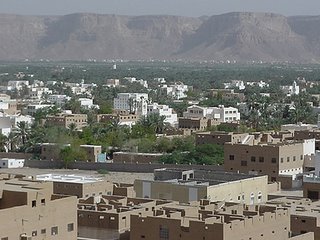Wady Hadhramout
 About 200 km. inland from Mukalla, at the Coast, is the very fertile valley of Wady Hadhramout; and it is where the historic city of Shibam is. Shibam - above - is under UNESCO's program for safeguarding cultural heritages - and is believed to be the first 'city of skyscrapers' in the world; note the striking resemblance to Manhattan - flying by air above - it is even more strikingly so. Shibam, built wholly of mud bricks like most houses in Wadi Hadhramaut, is about 500 years old. The mud bricked buildings, rise 5 to 9 story's high.
About 200 km. inland from Mukalla, at the Coast, is the very fertile valley of Wady Hadhramout; and it is where the historic city of Shibam is. Shibam - above - is under UNESCO's program for safeguarding cultural heritages - and is believed to be the first 'city of skyscrapers' in the world; note the striking resemblance to Manhattan - flying by air above - it is even more strikingly so. Shibam, built wholly of mud bricks like most houses in Wadi Hadhramaut, is about 500 years old. The mud bricked buildings, rise 5 to 9 story's high.From Mukalla, traveling inland - takes about three hours by road to cover the almost 300 km. to reach Shibam. One has to drive through a mountainous high plateau; about 70 km. from Shibam, the plateau ends and one enters the spectacular entrance of Wadi Hadhramout. From the high plateau, abruptly, one descends a very steep slope and as suddenly - the valley below opens up. It is like entering another world. Another planet! The date palm trees, the mud houses - some seeming to cling on mountain sides - and the valley itself, is just spellbinding. Too spectacular for words!
Some 15 km. before Shibam, is my home-town, Al Qatn. Just at the start of World War II, my late Father trekked from there - by foot and on camel to the Coast; and boarded a dhow to East Africa - never to return to Hadhramout, but only briefly once - till 1983.
 Wadi Hadhramaut is the longest valley in the Arabian Peninsula; it is about 170 km. long and between 500 m. and 13 km., wide. 'Wady' means valley, in Arabic; Hadhramout, some time spelt Hadhramaut, is mentioned in the Bible as 'Hazarmaveth': Book of Genesis 10:26-28 . It is said the name Hadhramout comes from the Greek word hydreumata - meaning an enclosed or fortified watering place or station. The largest town in the valley is Seiyoun: above picture.
Wadi Hadhramaut is the longest valley in the Arabian Peninsula; it is about 170 km. long and between 500 m. and 13 km., wide. 'Wady' means valley, in Arabic; Hadhramout, some time spelt Hadhramaut, is mentioned in the Bible as 'Hazarmaveth': Book of Genesis 10:26-28 . It is said the name Hadhramout comes from the Greek word hydreumata - meaning an enclosed or fortified watering place or station. The largest town in the valley is Seiyoun: above picture.Wady Hadhramout: mysterious, exotic and enchanting. A place where old traditions are still very much alive!
Read this interesting article on Wady Hadhramaut


Comments
Nice blog!
The pictures look green because Wady Hadhramout is very fertile; it is said to be one of the most fertile places in the world - similar to San Joaquin in California. Only a very small percentage of it is being irrigated now.
I didn't know the name is Hebrew! Thanks for that! 'Mawt' means death in Arabic too.